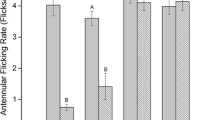Abstract
Three species of crayfish (Orconectes virilis, O. rusticus, andCambarus robustus) were tested for feeding responses to potential food odors from mollusks (either zebra mussels,Dreissena polymorpha, or native gastropods). In all three crayfish species, feeding responses to odor cues were shown only by individuals experienced with feeding on a prey type. Individuals exposed to just the smell of prey organisms did not show feeding responses, indicating the role of associative learning in diet breadth. Establishment of a learned association took more than one feeding experience but once established lasted more than three weeks. When microbial enzymatic degradation of food protein was eliminated, either by UV radiation or microfiltration, feeding responses were eliminated even for crayfish experienced with a prey type.
Similar content being viewed by others
References
Ameyaw-Akumfi, C. 1977. Feeding chemoreceptor sites in the crayfishProcambarus clarkii (Girard).Crustaceana 33:259–264.
Chambers, P.A., Hanson, J.M., Burke, J.M., andPrepas, E.E. 1990. The impact of the crayfishOrconectes virilis on aquatic macrophytes.Freshwater Biol. 24:81–91.
Connaughton, V.P., andEpifanio, C.E. 1993. Influence of previous experience on the feeding habits of larval weakfishCynoscion regalis.Mar. Ecol. Prog. Ser. 101:237–241.
Croll, R.P., andChase, R. 1980. Plasticity of olfactory orientation to foods in the snailAchatina fulica.J. Comp. Physiol. 136A:267–277.
Derby, C.D., andAtema, J. 1981. Selective improvement in responses to prey odor by the lobster,Homarus americanus, following feeding experience.J. Chem. Ecol. 7:1073–1080.
Dickinson, A. 1980. Contemporary Animal Learning Theory. Cambridge University Press, New York. 177 pp.
Flint, R.W., andGoldman, C.R. 1975. The effects of a benthic grazer on the primary productivity of the littoral zone of Lake Tahoe.Limnol. Oceanogr. 20:935–944.
Hazlett, B.A. 1994. Alarm responses in the crayfishOrconectes virilis andOrconectes propinquus.J. Chem. Ecol. 20:1525–1535.
Hobbs, H.H., III. 1993. Trophic relationships of North American freshwater crayfishes and shrimps.Contrib. Biol. Geol. Milwaukee Mus. 85:1–110.
Ikeshoji, T. 1984.S-Propenylcysteine sulfoxide in exudates of onion roots and its possible decompartmentalization in root cells by bacteria into attractant of the onion maggotHylemya antiqua (Diptera: Anthomyiidae).Appl. Entomol. Zool. 19:159–169.
Love, J., AndSavino, J.F. 1993. Crayfish (Orconectes virilis) predation on zebra mussels (Dreissena polymorpha).J. Freshwater Ecol. 8:253–259.
Ludyanskiy, M.L., McDonald, D., andMacNeill, D. 1993. Impact of the zebra mussel, a bivalve invader.Bioscience 43:533–544.
Momot, W.T., Gowing, H., andJones, P.D. 1978. The dynamics of crayfish and their role in ecosystems.Am. Midl. Nat. 99:10–35.
Rittschof, D. 1980. Enzymatic production of small molecules attracting hermit crabs to simulated gastropod predation sites.J. Chem. Ecol. 6:665–675.
Rittschof, D. 1993. Body odors and neutral-basic peptide mimics: A review of responses by marine organisms.Am. Zool. 33:487–493.
Tierney, A.J., andAtema, J. 1988. Behavioral responses of crayfish (Orconectes virilis andOrconectes rusticus) to chemical feeding stimulants.J. Chem. Ecol. 14:123–133.
Vissen, J.H. 1986. Host odor perception in phytophagous insects.Annu. Rev. Entomol. 31:121–144.
Waldbauer, G.P., andFriedman, S. 1991. Self-selection of optimal diets by insects.Annu. Rev. Entomol. 36:43–63.
Wood, L. 1968. Physiological and ecological aspects of prey selection by the marine gastropodUrosalpinx cinerea (Prosobranchia: Muricidae).Malacolgia 6:267–320.
Author information
Authors and Affiliations
Rights and permissions
About this article
Cite this article
Hazlett, B.A. Crayfish feeding responses to zebra mussels depend on microorganisms and learning. J Chem Ecol 20, 2623–2630 (1994). https://doi.org/10.1007/BF02036196
Received:
Accepted:
Issue Date:
DOI: https://doi.org/10.1007/BF02036196




